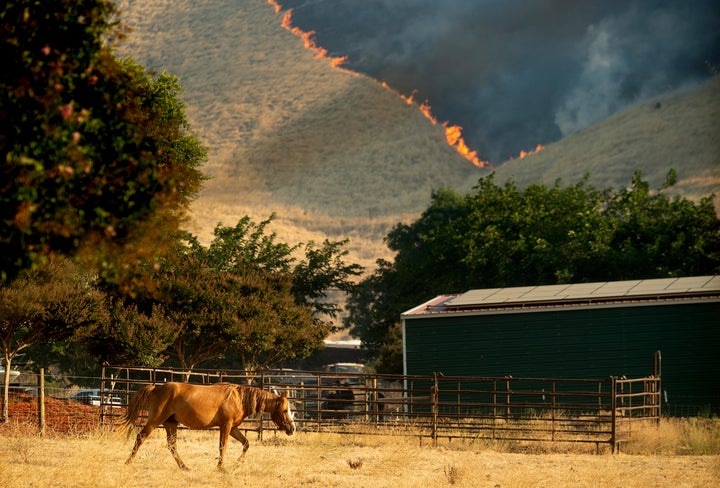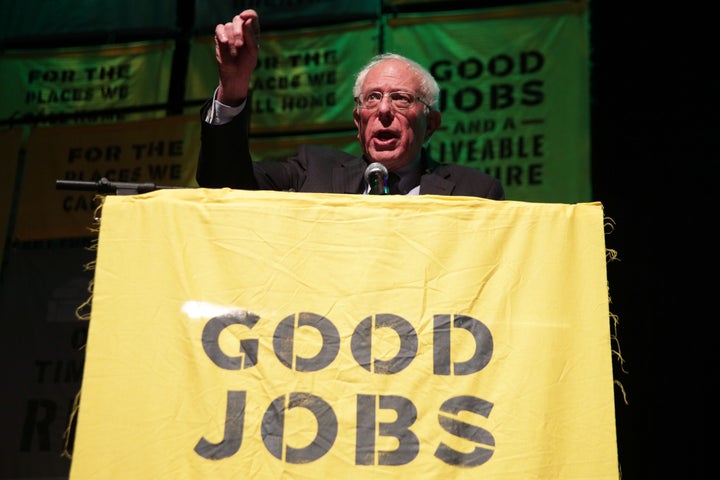Democratic presidential hopeful Bernie Sanders released a sweeping $16.3 trillion climate plan on Thursday, vowing to create 20 million jobs and completely zero out planet-heating emissions by 2050.
The proposal outlines easily the most ambitious vision for a Green New Deal to date, with calls to massively expand public ownership of everything from power generation to groceries. With Washington Gov. Jay Inslee ending his climate-centered bid for the Democratic nomination a day earlier, the plan vaults the Vermont senator ahead of his 2020 rivals on what’s emerging as the defining policy issue of the Democratic primary.
At a moment when record wildfires are raging from the Amazon to the Arctic and Greenland is losing up to 12.5 billion tons of ice in a single day, the plan is dense with detail and frank in its goals. Where other proposals, including those from Inslee and Sen. Elizabeth Warren (D-Mass.) depict expanded regulatory regimes and public spending aimed at spurring private investment, Sanders charts out a path to a hospitable global climate through Nordic-style social democracy.
“The scope of the challenge ahead of us shares some similarities with the crisis faced by President Franklin Delano Roosevelt in the 1940s,” the plan states. “Faced with battling a world war on two fronts ― both in the East and the West ― the United States came together, and within three short years restructured the entire economy in order to win the war and defeat fascism. As president, Bernie Sanders will boldly embrace the moral imperative of addressing the climate crisis.”
The campaign declined a request to interview Sanders on Wednesday evening.
The plan opens with Sanders vowing to slash U.S. emissions 71% below 2017 levels by 2030 with 100% renewable electricity and zero-emissions vehicles. He declares war on the fossil fuel industry with proposed bans on fracking, drilling on public lands and all imports and exports of oil and gas, and threatens companies with civil and criminal charges for pollution and obstructing climate action. He pledges $200 billion to help developing countries reduce their own climate pollution by 36% in the next decade.
Citing the nuclear disasters in Chernobyl and Fukushima, Sanders, long a critic of nuclear power, swears off new reactors and promises a moratorium on future licenses to existing plants. His plan rules out geoengineering the climate or deploying technologies to capture carbon dioxide from fossil fuel plants, which he derided as “false solutions.” It’s unclear whether he’d consider carbon capture technologies for difficult-to-decarbonize industries like cement making.

Generous pledges for workers animate Sanders’ proposal. The plan, which comes the same week the campaign released its proposal to boost unions, promises five years of unemployment insurance, a wage guarantee, housing assistance, job training, pension support and priority job placement for all workers displaced by the transition. It offers “early retirement support for those who choose it or can no longer work.” It proposes high wages and union protections across nearly every sector.
What stands out first is Sanders’ clear answer to the perennial question of how to pay for it.
There’s the money saved: $1.215 trillion from “scaling back military spending on protecting global oil” and $1.31 trillion from federal and state welfare “due to the creation of millions of good-paying, unionized jobs.”
Then there’s the money earned: $6.4 trillion from selling electricity produced by the Energy Department’s regional power marketing authorities, $3.085 trillion from “making the fossil fuel industry pay for their pollution, through litigation, fees, and taxes, and eliminating federal fossil fuel subsidies,” $2.3 trillion from income taxes on the 20 million new jobs the plan creates, and an additional $2 trillion from forcing “the wealthy and large corporations pay their fair share.”
Those pushing a Green New Deal, including Rep. Alexandria Ocasio-Cortez (D-N.Y.) and the grassroots group Sunrise Movement, have shied away from talking numbers, even as Republicans fabricated a bogus $93 trillion price tag. Instead, advocates have pointed to the costs of sticking to a business-as-usual. The Sanders plan touches on that, too, highlighting that the costs of catastrophic warming could total $70.4 trillion over 80 years.
“This plan will pay for itself over 15 years,” the policy memo reads. “Experts have scored the plan and its economic effects.”
The 13,840-word document includes 85 dollar signs. Sanders sets aside $5.9 billion for regional economic development plans, with the lion’s share ― over $2.5 billion ― earmarked for Appalachia. There’s $15 billion for coal miners’ Black Lung Disability Fund. Another $25 billion goes to clearing the national park maintenance backlog. The restored Civilian Conservation Corps, a New Deal program that planted 3 billion trees in the 1930s, gets $171 billion.
Righting The New Deal’s Wrongs
Yet the plan aims to correct the original New Deal’s racist legacy. It envisions a beefed up Office of Civil Rights at the Environmental Protection Agency and vows to give “minority and women-owned businesses, cooperatives and employee-owned firms” priority in federal contracts. It promises to adhere to the principles of environmental justice set out at the First National People of Color Environmental Leadership Summit in 1991 and abide by the United Nations Declaration on the Rights of Indigenous Peoples.
The plan calls for creating a $40 billion Climate Justice Resiliency Fund at the Environmental Protection Agency to “conduct a nationwide survey to identify areas with high climate impact vulnerabilities and other socioeconomic factors, public health challenges, and environmental hazards,” then offer block grants “in order of most vulnerable to least vulnerable.” The program would establish a special Office of Climate Resiliency for People with Disabilities to “ensure that nationwide, the needs of people with disabilities are consistently addressed during adaptation planning and that those efforts are coordinated throughout the federal government.”
“The first two years of this plan will be spent very aggressively laying down a social safety net to ensure that no one is left behind,” the proposal reads. “Because this plan is so comprehensive in ensuring we solve the climate crisis, we must prioritize establishing a social safety net in the first years of the implementation of this plan.”
Water factors heavily into the plan. Sanders, who in February introduced the $35 billion WATER Act to overhaul drinking water infrastructure, calls for its passage in the plan as a means of freeing communities from Flint, Michigan, to Newark, New Jersey, of lead and toxic chemical contaminations.

It’s unclear how much of the plan will cover the American territories of Puerto Rico, the Northern Mariana Islands, Guam, the U.S. Virgin Islands and American Samoa. But the proposal promises to expand federal food stamp protections to all five.
In an email, a Sanders spokesman said resiliency fund would ”provide significant funding to the territories for a just transition including real jobs, resilient infrastructure, economic development.”
‘Not Mine. Ours.’
Where Sanders’ plan diverges most from those of Warren, Inslee and others is in its explicit calls for scaling the public sector in ways unseen since the 1940s. Power marketing administrations, seldom-discussed agencies under the Energy Department that operate transmission lines and sell electricity generated at federally owned hydro dams, are central to the plan. The federal government built four such regional administrations between 1937 and 1977. Sanders calls for building a fifth to cover the states and territories currently outside the other four’s jurisdiction. He earmarks $1.52 trillion to convert the entire operations to wind, solar and geothermal, and an additional $852 billion to build energy storage capacity.
The federal revenues from ratepayers are expected to fund the Green New Deal. But the build-out of fuel-free electricity means that, per the plan, “after 2035 electricity will be virtually free, aside from operations and maintenance costs.”
The plan even offers $14.7 billion in federal investments in cooperatively owned grocery stores.
“Local groceries and co-ops are more likely to buy local products, which will help grow markets for farmers to sell their goods,” the plan reads. “We will also use these funds to bring grocery stores to food deserts ensuring all people have access to healthy, local food.”
Harkening to the rural revitalization plan Sanders released earlier this year, the proposal makes a vague call to “incentivize community ownership of farmland.”
“The scope of the challenge ahead of us shares some similarities with the crisis faced by President Franklin Delano Roosevelt in the 1940s.”
“One of the barriers to being able to choose a career in ecologically regenerative farming is the cost of acquiring farmland,” it states. “We want communities to be able to join together to own farmland to help people grow our local, ecologically regeneratively produced food and help solve the climate crisis and will provide government assistance to do so.”
Market Wisdom
It’s easy to imagine the political right smearing the proposal as a Soviet-style takeover by an avowed democratic socialist. In reality, the plan leans more toward the first half of Sanders’ self-professed ideological bent than the latter.
The proposal redirects subsidies and incentives heaped on big businesses to small ones. It invests $31 billion in local food plants, including slaughterhouses and dairy processors.
“Rampant consolidation in processing has led to a lack of facilities for small-scale, local producers,” it reads. “Investing in local facilities will help smaller producers to compete with the Tyson Foods of the world.”
The plan provides nearly $3 trillion in grants to lower-income families and small businesses to trade in combustion-engine vehicles for all-electric alternatives. It offers tax credits to businesses that hire workers transitioning out of fossil fuel jobs. Nearly $2.2 trillion is budgeted for grants to homeowners and small businesses to weatherize buildings. An additional $964 billion goes to grants for those same homeowners and businesses to replace gas-fired appliances with electric alternatives.
It sets aside $410 billion to pay farmers to store carbon dioxide in soil and “transition to ecologically regenerative agricultural practices that rebuild rural communities, protect the climate, and strengthen the environment.”
“We need a president who has the courage, the vision, and the record to face down the greed of fossil fuel executives and the billionaire class who stand in the way of climate action,” the memo reads. “We need a president who welcomes their hatred. Bernie will lead our country to enact the Green New Deal and bring the world together to defeat the existential threat of climate change.”

